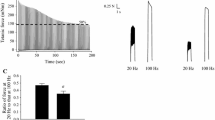Abstract
This study investigated whether carnosine alters individual processes involved in normal excitation–contraction (E–C) coupling in mammalian skeletal muscle fibres. Mechanically-skinned fibre preparations were utilized because they allow carnosine to be precisely and readily applied to the cytoplasmic environment as desired, whilst still retaining the normal E–C coupling mechanism. Carnosine caused an increase (∼+0.02 to ∼+0.09 pCa units) in Ca2+-sensitivity of the contractile apparatus in a concentration-dependent manner (i.e. with 4, 8 and 16 mM respectively). Force responses elicited by 8 mM caffeine-induced Ca2+ release from the sarcoplasmic reticulum (SR) were potentiated in the presence of carnosine (compared to the bracketing responses in the absence of carnosine). Force responses elicited by transverse tubular (T-) system depolarization via the dihydropyridine receptors (DHPRs), either by ionic (Na+) substitution or by action potentials (APs), were also potentiated in a concentration-dependent manner in the presence of carnosine. The potentiation of the force responses in all of the various experiments was seemingly totally explicable by the increase in Ca2+-sensitivity of the contractile apparatus caused by carnosine. Thus, these results show that carnosine potentiates force responses solely by 'sensitizing' the contractile apparatus to Ca2+ ions and under physiological conditions does not cause additional Ca2+ release from the SR.
Similar content being viewed by others
References
Abe H (2000) Role of histidine-related compounds as intracellular proton buffering constituents in vertebrate muscle. Biochemistry (Moscow) 65(7):757–765.
Batrukova MA and Rubtsov AM (1997) Histidine-Containing dipeptides as endogenous regulators of the activity of sarcoplasmic reticulum Ca2+-release channels. Biochim Biophys Acta 1324: 142–150.
Boldyrev AA (2000) Problems and perspectives in studying the biological role of carnosine. Biochemistry (Moscow) 65(7): 751–756.
Dunnett M, Harris RC, Soliman MZ and Suwar AAS (1997) Carnosine, anserine and taurine contents in individual fibres from the middle gluteal muscle of the camel. Res in Veterinary Sci 62(3): 213–216.
Fryer MW and Stephenson DG (1996) Total and sarcoplasmic reticulum calcium contents of skinned fibres from rat skeletal muscle. J Physiol 493: 357–370.
Harris RC, Dunnett M and Greenhaff PL (1998) Carnosine and taurine contents in individual fibres of human vastus lateralis muscle. J Sports Sciences 16: 639–643.
Lamb GD (2002a) Voltage-sensor control of Ca2+release in skeletal muscle: insights from skinned fibers. Frontiers Biosci 7: 834–842.
Lamb GD (2002b) Excitation-contraction coupling and fatigue mechanisms in skeletal muscle: studies with mechanically-skinned fibres. J Muscle Res Cell Motility 23: 81–91.
Lamb GD and Stephenson DG (1990). Calcium release in skinned muscle fibres of the toad by transverse tubule depolarization or by direct stimulation. J Physiol 423: 495–517.
Lamb GD and Stephenson DG (1991) Effect of Mg2+on the control of Ca2+release in skeletal muscle fibres of the toad. J Physiol 434: 507–528.
Lamb GD and Stephenson DG (1992) Importance of Mg2+in excitation-contraction coupling in skeletal muscle. News Physiol Sci 7: 270–274.
Lamb GD and Stephenson DG (1994) Effect of intracellular pH and [Mg2+] on excitation-contraction coupling in skeletal muscle fibres of the rat. J Physiol 489: 331–339.
Lamb GD and Posterino GS (2003) Effect of oxidation and reduction on contractile function in skeletal muscle fibres of the rat. J Physiol 546.1: 149–163.
Lamb GD, Stephenson DG and Stienen GJM (1993) Effects of osmolality and ionic strength on the mechanism of Ca2+release in skinned skeletal muscle fibres of the toad. J Physiol 464: 629–648.
Lamb GD, Cellini MA and Stephenson DG (2001) Different Ca2+ releasing action of caffeine and depolarisation in skeletal muscle fibres of the rat. J Physiol 531: 715–728.
Lamont C and Miller DJ (1992) Calcium sensitizing action of carnosine and other endogenous imidazoles in chemically skinned striated muscle. J Physiol 454: 421–434.
Mannion AF, Jakeman PM, Dunnett M, Harris RC and Willan PLT (1992) Carnosine and anserine concentrations in the quadriceps femoris muscle of healthy humans. Eur J Appl Physiol and Occupation Physiol 64 (1): 47–50.
Maynard LM, Boissonneault GA, Chow CK and Bruckner GG (2001) High levels of dietary carnosine are associated with increased concentrations of carnosine and histidine in rat soleus muscle. J Nutrition 131: 287–290.
Meissner G (1994) Ryanodine receptor/Ca2+release channels and their regulation by endogenous effectors. Ann Rev Physiol 56: 485–508.
Nagasawa T, Yonekura T, Nishizawa N and Kitts DD (2001) In vitro and in vivo inhibition of muscle lipid and protein oxidation by carnosine. Mol Cellular Biochem 225: 29–34.
Posterino GS, Cellini MA and Lamb GD (2003) Effects of oxidation and cytosolic redox conditions on excitation-contraction coupling in rat skeletal muscle. J Physiol 547: 807–823.
Posterino GS and Lamb GD (2003) Effect of sarcoplasmic reticulum Ca2+content on action potential-induced Ca2+release in rat skeletal muscle fibres. J Physiol 551: 219–237.
Posterino GS, Lamb GD and Stephenson DG (2000) Twitch and tetanic force responses and longitudinal propagation of action potentials in skinned skeletal muscle fibres. J Physiol 527: 131–137.
Rubtsov AM (2001) Molecular mechanisms of regulation of the activity of sarcoplasmic reticulum Ca-release channels (ryanodine receptors), muscle fatigue and Severin's phenomenon. Biochem (Moscow) 66: 1132–1143.
Sewell DA, Harris RC, Marlin DJ and Dunnett M (1992) Estimation of the carnosine content of different fibre types in the middle gluteal muscle of the thoroughbred horse. J Physiol 455: 447–453.
Stephenson DG and Williams DA (1981) Calcium-activated force responses in fast-and slow-twitch skinned muscle fibres of the rat at different temperatures. J Physiol 317: 281–302.
Stuerenburg HJ (2000) The roles of carnosine in ageing of skeletal muscle and in neuromuscular diseases. Biochem (Moscow) 65(7): 862–865.
Wendt IR and Stephenson DG (1983) Effects of caffeine on Ca2+-activated force production in skinned cardiac and skeletal muscle fibres of the rat. Pflugers Archiv 398: 210–216.
Zapata-Sudo G, Sudo RT, Lin M and Nelson TE (1997) Calciumsensitizing function for the dipeptide carnosine in skeletal muscle contractility. Cell Physiol Biochem 7: 81–92.
Author information
Authors and Affiliations
Rights and permissions
About this article
Cite this article
Dutka, T.L., Lamb, G.D. Effect of Carnosine on Excitation–Contraction Coupling in Mechanically-Skinned Rat Skeletal Muscle. J Muscle Res Cell Motil 25, 203–213 (2004). https://doi.org/10.1023/B:JURE.0000038265.37022.c5
Issue Date:
DOI: https://doi.org/10.1023/B:JURE.0000038265.37022.c5




